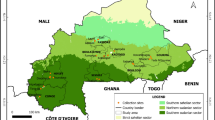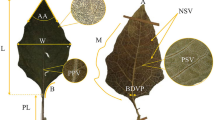Summary
A collection of subterranean clover lines singled out from populations of the species Trifolium brachycalycinum and T. subterraneum collected in Sicily, Italy, was examined at two localities for flowering time and at one locality for oestrogen content and seed yield. The structure and variation of the populations of the two species were compared. The relationship between flowering time of the populations and some environmental features of their collection sites was examined to assess whether the maturity requirements of the two species were similar and to frame selection models focused on developing varieties of appropriate maturity. Populations of T. subterraneum were, on average, more complex than those of T. brachycalycinum, being characterized by higher number of lines per population and greater intra-population variation for flowering time, oestrogen content and seed yield. Furthermore, populations of T. subterraneum were, on average, about 15 days earlier than sympatric populations of T. brachycalycinum. Both the greater variation and the relative earliness of T. subterraneum occurred irrespective of the environments of origin of the populations. Inferences are drawn on the adaptive advantages that such features confer to T. subterraneum. Mean flowering time of the populations increased on increasing annual rainfall and altitude of the collection sites. However, the changes in maturity appeared almost exclusively related to variations in rainfall in T. subterraneum, while in T. brachycalycinum the effect of altitude was greater and that of rainfall less marked than in the former species.
Similar content being viewed by others
References
Aitken Y., 1955a. Flower initiation in pasture legumes. 1. Factors affecting flower initiation in Trifolium subterraneum L. Aust. J. Agric. Res. 6: 212–244.
Aitken Y., 1955b. Flower initiation in pasture legumes. 2. Geographical implications of cold temperature requirements of varieties of Trifolium subterraneum L. Aust. J. Agric. Res. 6: 245–257.
Anonymous, 1971. Atlante di idrologia agraria per la Sicilia. University of Palermo.
Bolland M.D.A. & W.J.Collins, 1986. Effect of burr burial on seed production of Trifolium subterraneum subsp. brachyaclycinum and other annual legumes. Aust. J. Exp. Agric. 26: 59–64.
Collins, W.J. & J.S. Gladstones, 1984. Breeding to improve subterranean clover in Australia. In: R.F. Barnes, P.R. Ball, R.W. Brougham, G.C. Marten & D.J. Minson (Eds). Forage legumes for energy-efficient animal production. p. 308–316. USDA, ARS.
Collins W.J., C.M.Francis & B.J.Quinlivan, 1976. The interrelation of burr burial, seed yield and dormancy in strains of subterranean clover. Aust. J. Agric. Res. 27: 787–797.
Crespo D.G., 1970. Some agronomic aspects of selecting subterranean clover (Trifolium subterraneum L.) from Portuguese ecotypes. In: Proc. XI Int. Grassl. Congr., p. 207–210. University of Queensland Press, St. Lucia.
Devitt A.C., B.J.Quinlivan & C.M.Francis. 1978. The flowering of annual legume pasture species and cultivars in Western Australia. Aust. J. Exp. Agric. Anim. Husb. 18: 75–80.
Evans L.T., 1959. Flower initiation in Trifolium subterraneum L. I. Analysis of the partial processes involved. Aust. J. Agric. Res. 10: 1–16.
Evans P.M., R.J.Lawn & A.R.Watkinson, 1992. Use of linear models to predict the date of flowering in cultivars of subterranean clover (Trifolium subterraneum L.). Aust. J. Agric. Res. 43: 1547–1558.
Francis C.M., A. RamosMonreal & B.J.Quinlivan, 1978. Predicting the maturity requirements of subterranean clover cultivars for farm grazing in Extremadura, Spain. Aust. Pl. Introd. Rev. 12: 14–19.
Gladstones J.S., 1966. Naturalized subterranean clover (Trifolium subterraneum L.) in Western Australia: the strains, their distributions, characteristics and possible origins. Aust. J. Bot. 14: 329–354.
Gladstones J.S., 1967. Naturalized subterranean clover strains in Western Australia: a preliminary agronomic examination. Aust. J. Agric. Res. 18: 713–731.
Gladstones J.S. & W.J.Collins, 1983. Subterranean clover as a naturalized plant in Australia. J. Aust. Inst. Agric. Sci. 49: 191–202.
Gladstones, J.S. & W.J. Collins, 1984. Naturalized subterranean clover strains of Western Australia. Technical Bulletin No. 64. Western Australia Department of Agriculture.
Gomez Pitera C., 1975. Algunos aspectos de los ecotipos de trebol subterraneo de los pastos naturales en el S.O. de España. Pastos 4: 2.
Katznelson J., 1974. Biological flora of Israel. 5. The subterranean clovers of Trifolium subsect. Calycomorphum Katzn. Trifolium subterraneum L. (sensu lato). Isr. J. Bot. 23: 69–108.
Katznelson J. & F.H.W.Morley, 1965. Speciation processes in Trifolium subterraneum L. Isr. J. Bot. 14: 15–35.
Marshall D.R. & P.Broué, 1973. Outcrossing rates in Australian populations of subterranean clover. Aust. J. Agric. Res. 24: 863–867.
Morley F.H.W., 1958. Effect of strain and temperature on the growth of subterranean clover (Trifolium subterraneum L.). Aust. J. Agric. Res. 9: 745–753.
Morley F.H.W., 1961. Subterranean clover. Adv. Agron. 13: 57–123.
Morley F.H.W. & C.I.Davern, 1956. Flowering time in subterranean clover. Aust. J. Agric. Res. 7: 388–400.
Morley F.H.W. & L.T.Evans, 1959. Flower initiation in Trifolium subterraneum L. II. Limitations by vernalization, low temperatures, and photoperiod, in the field at Canberra. Aust. J. Agric. Res. 10: 17–26.
Morley F.H.W. & J.Katznelson, 1965. Colonization in Australia by Trifolium subterraneum L. In: The genetics of colonizing species. p. 269–285. Academic Press Inc., New York.
Piano E., 1984. Preliminary observations on the structure and variability of Sardinian populations of subterranean clover. Genet. Agr. 38: 75–90.
Piano, E., 1987a. Aspects of the variability of subterranean clover populations and their implications in breeding. Maturity differences between the subspecies brachycalycinum Katzn. et Morley and subterraneum L. In: Annual self-reseeding legumes for Mediterranean pastures. p. 49–64. AGRIMED.
Piano, E., 1987b. Main objectives of subterranean clover improvement in Sardinia. In: Annual self-reseeding legumes for Mediterranean pastures. p. 33–47. AGRIMED.
Piano E., M.Sardara & S.Pusceddu, 1982. Observations on the distribution and ecology of subterranean clover and other annual legumes in Sardinia. Riv. di Agron. 16: 273–283.
Piano, E., S. Pusceddu & F. Spanu, 1991. Observations on the distribution and ecology of annual medics and subterranean clovers in Sicily (Italy). In: Proc. IV Int. Rangel. Congr., Montpellier, France. p. 405–409.
Quinlivan B.J. & C.M.Francis, 1971. The effect of burr burial on the seed of some early maturing subterranean clover cultivars. Aust. J. Exp. Agric. Anim. Husb. 11: 35–38.
Rossiter R.C., 1959. The influence of maturity grading on total yield and seed production in strains of Trifolium subterraneum L. grown as single plants and in swards. Aust. J. Agric. Res. 10: 305–321.
Rossiter R.C., 1966. The success or failure of strains of Trifolium subterraneum L. in a Mediterranean environment. Aust. J. Agric. Res. 17: 425–446.
Spanu F., A.Tava, L.Pecetti & E.Piano, 1993. Variability of oestrogenic isoflavone content in a collection of subterranean clover from Sicily. J. Genet. & Breed., 47: 27–34.
Tan B.H., 1985. Genetic control of flowering time in subterranean clover. Aust. J. Agric. Res. 36: 275–284.
Yates J.J., 1961. Seed-setting in subterranean clover (Trifolium subterraneum L.). III. The effect of plant density. Aust. J. Agric. Res. 12: 10–26.
Author information
Authors and Affiliations
Rights and permissions
About this article
Cite this article
Piano, E., Spanu, F. & Pecetti, L. Structure and variation of subterranean clover populations from Sicily, Italy. Euphytica 68, 43–51 (1993). https://doi.org/10.1007/BF00024153
Received:
Accepted:
Issue Date:
DOI: https://doi.org/10.1007/BF00024153




